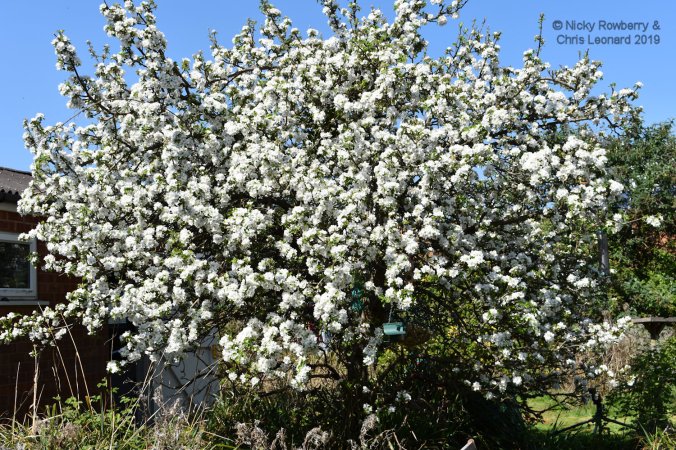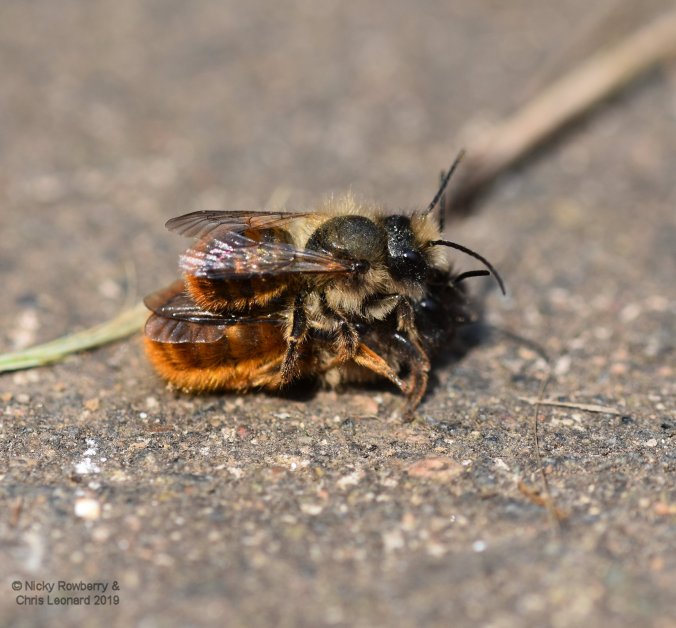The fabulous weather over the Easter weekend brought the blossom out in full force on our apple tree and with it a flurry of bees all around the garden. The tree is of the Discovery variety so produces early blossom for early apples and the bees certainly seemed to appreciate it.
I have two bee hotel boxes on the garage wall just a few feet away from the apple tree. These were used last year by both red mason bees and some leaf-cutter ones. So far this year it has mainly been the red mason bees buzzing around it. Initially all I could see were several red masons flying up to the holes, checking them out and rapidly flying away again. They were not only really quick, but the bee hotel is quite high up on the wall which meant I had to wobble about on a chair to try and get a photo – all of which goes to excuse this blurry shot!
I couldn’t understand at first why they kept coming and going, without actually going into any of the tubes. They would repeatedly check out the same tube. A quick google revealed that they were probably males, who emerge first. The females emerge a bit later having been laid further back in the tubes and the males were hovering around waiting for a fresh female to emerge. Having failed to get a decent still photo, I tried to get a video of them using the GoPro on a stick (more wobbling about) with mixed success:
The females must have started to emerge a few days ago. The males clearly don’t hang about or spend a long time “wooing” the females, as I found this happy couple immediately below the bee hotels. It looked as if the male had grabbed the female immediately as she emerged and the pair had dropped to the ground.
A bit of grovelling on the ground and I managed to get a video of the loved up pair.
The males are a good bit smaller than the females and he does look a bit like he’s hanging on for dear life. She also doesn’t look that impressed and seems more bothered by washing her antennae!
With the apple blossom so close to the bee boxes, it provides plenty of pollen for the bees right on their doorstep.
The red masons obviously aren’t the only ones making the most of the blossom while it lasts. I’ve counted at least 8 species on the tree in the last week, but here are just three – a Nomada bee, an Ashy Mining Bee and a Red-tailed Bumblebee.
We already have the two bee hotels on the side of the garage, one on the front of the house and one old one just lying in the garden. The spring sunshine seemed the perfect opportunity to get the old one back up and add a new one to the bees’ property portfolio. The neighbours had replaced the fence between us last year and it catches the sun for a lot of the day, so it is the perfect place for more bee hotels. So the old one went up along with this new beauty. There may be more to follow as the fence looks very bare and basically – why not?
I’ve not managed to get photos yet of any bees using the new one, but within hours there were a couple of red mason bees checking it out.
Bees of course were finding places to nest long before we started thinking of providing bee hotels. This, I think, is the entrance to a ground nesting bee’s nest – possibly one of the Andrena species. There are a few of these little holes dotted around our so-called lawn.
Every garden must have space for at least one bee hotel/bug house. Even if you don’t really have a garden you could put one on an outside wall. So why not give a home for nature and put up a bee hotel?












































